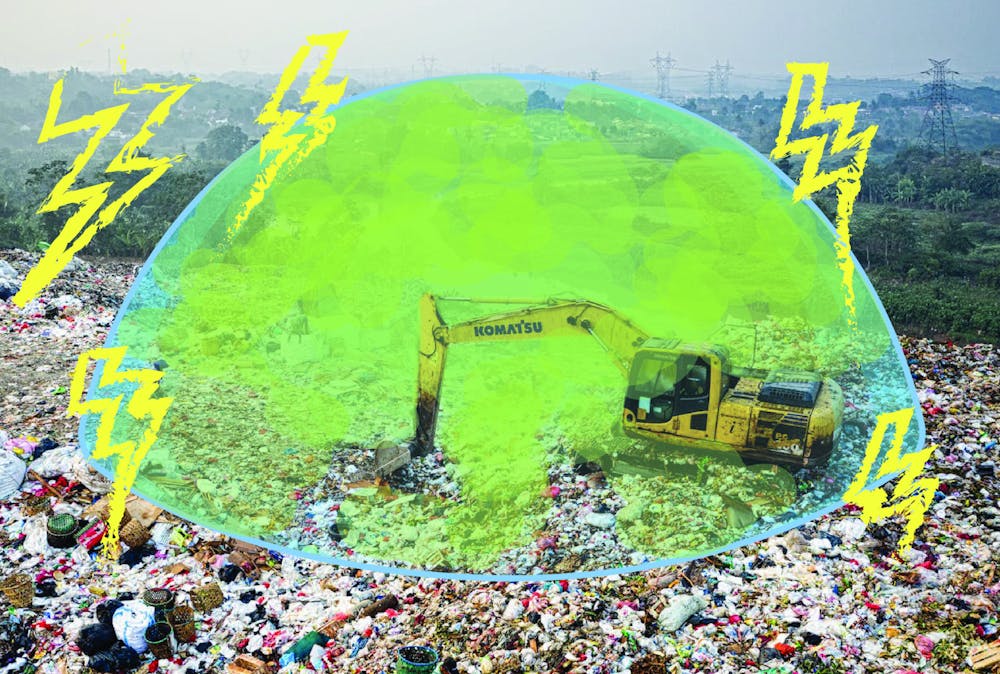Banana peels and egg shells, tree trimmings and excess mulch, doggie waste and leftovers. All of this household waste has one common characteristic: When Rumpke eventually dumps these scraps into the local landfill, they go through anaerobic decomposition, releasing exorbitant amounts of methane into our atmosphere.
Methane may have less buzz than carbon dioxide, but the greenhouse gas is 25 times more potent than CO2. Landfills constitute 16.9% of U.S. methane emissions, but it soon could be zero.
Composting and food scrap collection is the local answer to reducing landfill methane emissions; less organic matter ending up in landfills leads to less methane production. Yet, this solution depends on a widespread change in household habits and an uptick in utility costs.
In a previous article, I spoke with Dave Treleaven, the Environmental Coordinator for the City of Oxford, about the possibility of curbside organic waste pickup. Treleaven said the program would add around $20 per month to residents' utility bills, a price that most residents aren’t willing to pay.
These local efforts for organic waste collection should absolutely be pursued, but to effectively combat methane emissions, there must be a larger-scale response: a national infrastructure of methane capture systems that convert emissions from trash into natural gas.
The use of natural gas has exploded in the last two decades. According to the Alliance for Innovation and Infrastructure, an independent non-profit founded by Miami University research associate Brigham McCown, natural gas generates 40.3% of America’s electricity, the largest share of all energy resources. Natural gas has been popularized for its clean burning properties and cost-effectiveness, yet most natural gas is acquired through fracking, an exhaustible, non-renewable process.
Fracking exists throughout America, including Ohio and Indiana, but the region could now be known for a new method of natural gas production.
In Medora, Indiana, a small town in our tri-state area, methane emissions from trash at a Rumpke plant are being transformed into Renewable Natural Gas (RNG). This biogas not only improves local air quality and slows emissions, it can power our lives, heating around 13,000 homes per year from landfill waste.
In addition to the Medora plant, there are 532 RNG plants across the United States, but Medora’s, built by BP and designed by Archaea, is a first of its kind. Archaea’s design “allows plants to be built on skids with interchangeable components for faster builds.” BP’s advance into the renewable natural gas sector could exemplify the future of America’s pursuit of clean energy, but states must actively participate.
In 2023, the renewable energy portfolio standard for Ohio requires that only 8.5% of electricity sold must be generated from renewable energy sources by 2026. This meager goal could be accomplished, and raised, by the creation of, and dependence on, renewable natural gas plants.
The American Biogas Council estimates that the buildout of extensive biogas collection infrastructure in Ohio would reduce greenhouse gas emissions equivalent to removing 3.53 million cars from the road. Additionally, they estimate that a national build-out would create around 25,000 permanent jobs across the country and lead to $1.33 billion in capital investments.
BP is planning to expand its biogas production sixfold by 2030, but states and local governments must increase their policies along with the private sector. Investing in methane capture and providing larger incentives will slow the warming of our planet and continue to power our lives. Ohio needs to raise its renewable electricity requirements and purposefully invest in methane capture systems.
Enjoy what you're reading?
Signup for our newsletter
Although the abundance of trash negatively impacts our earth, it is an inevitable part of daily life. Effectively combating greenhouse gas emissions is finding practical solutions that benefit the average household, and renewable natural gas production from methane is an answer.
The willingness of Rumpke to pair with BP is a step forward in reducing GHG emissions and gives a brighter energy future for places like Oxford.




